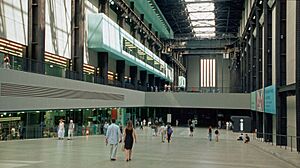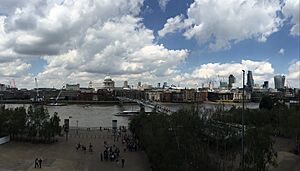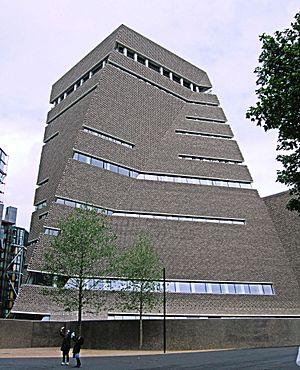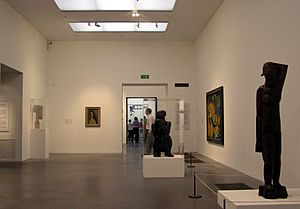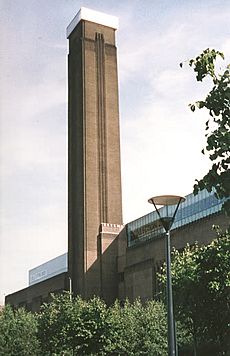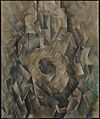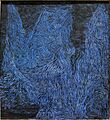Tate Modern facts for kids
 |
|

Tate Modern in 2018
|
|
| Lua error in Module:Location_map at line 420: attempt to index field 'wikibase' (a nil value). | |
| Established | 2000 |
|---|---|
| Location | Bankside London, SE1 United Kingdom |
| Visitors | 4,742,038 (2023) |
| Public transit access | |
| Tate | |
|
|
The Tate Modern is a super cool art gallery in London. It's home to the United Kingdom's amazing collection of international modern and contemporary art. This means you can see art created from the year 1900 all the way up to today!
Tate Modern is part of a bigger group called Tate. This group also includes Tate Britain, Tate Liverpool, and Tate St Ives. You can find Tate Modern in the Bankside area of London. It's built inside what used to be a huge power station!
It's one of the biggest museums in the world for modern and contemporary art. Millions of people visit it every year. The best part? You don't have to pay to see most of the art! You only need tickets for special temporary exhibitions.
In 2023, over 4.7 million people visited Tate Modern. This makes it one of the most popular art museums globally. The closest train and London Underground station is Blackfriars.
Contents
The Story of Tate Modern
From Power Station to Art Gallery
For many years, the Tate galleries shared a building called Tate Britain. But in 2000, Tate Modern opened in its own special place. This new home was once the Bankside Power Station.
A famous architect named Sir Giles Gilbert Scott designed the power station. It was built between 1947 and 1963. It sits right across the River Thames from the famous St Paul's Cathedral. The power station stopped working in 1981.
The building was very long, about 200 meters (656 feet). It had a tall chimney that was 99 meters (325 feet) high. Inside, there were three main parts. The biggest was the huge Turbine Hall in the middle. This is where the machines that made electricity used to be.
Making a New Museum
After the power station closed, some people wanted to knock it down. But many others fought to save the building. They thought it could be used for something new and exciting.
In 1994, the Tate Gallery announced that Bankside would become the new Tate Modern. An international competition was held to find the best architects for the job. Herzog & de Meuron won the competition in 1995.
The work to change the power station into an art gallery cost £134 million. It started in June 1995 and was finished in January 2000. One big change you can see from outside is the two-story glass part added to the roof. Inside, many of the original parts were kept, like the giant Turbine Hall.
The Queen, Elizabeth II, officially opened Tate Modern on May 11, 2000. It was a huge success! In its first year, 5.25 million people visited. Before that, all three other Tate galleries together only had 2.5 million visitors.
Growing Bigger: The Extension Project
Tate Modern became much more popular than anyone expected. So, plans were made to make it even bigger. These plans started in 2004. The goal was to almost double the amount of space for art.
Part of the original power station building was still used by an electricity company. In 2006, the company gave up some of its space. This allowed for a new tower to be built for the museum. This tower was built over old oil storage tanks. These tanks were also turned into cool new art spaces.
The whole extension project cost a lot of money, about £260 million. Many people and groups helped by donating money. For example, a businessman named Eyal Ofer gave £10 million in 2013.
The Tanks
The first part of the expansion opened in 2012. This involved turning three large, round, underground oil tanks into art spaces. These "Tanks" were originally used to store fuel for the power station.
Two of the Tanks are now used to show live performance art and special art installations. Tate says they are the world's first museum galleries made just for live art.
The Blavatnik Building
A tall, ten-story tower was built above the oil tanks. It's about 65 meters (213 feet) high. This new building opened to the public on June 17, 2016.
The architects, Herzog & de Meuron, designed it with a special brick pattern. This pattern helps it match the original power station building. The new building added lots of space for art, education, offices, and places to eat and shop.
In 2017, the new tower was officially named the Blavatnik Building. This was to thank Sir Leonard Blavatnik, who gave a very large donation to help build it.
What You Can See: The Galleries
Tate Modern's collection includes modern and contemporary art from 1900 to today.
The museum has different levels with gallery spaces. Levels 2, 3, and 4 in the original Boiler House building show art from 1900 to the present day. The new Blavatnik Building (levels 0, 2, 3, and 4) shows art from 1960 to today.
The Turbine Hall is a massive, tall space that runs through the middle of the building. It's six stories high! This huge area is perfect for showing really big artworks that wouldn't fit anywhere else.
Special Exhibitions and Artworks
Main Collection Displays
The main art displays are organized into different themes or subjects. For example, you might find sections like Artist and Society or Materials and Objects. Within these themes, some rooms change their artworks regularly. It's always free to visit these main collection areas.
How the Art is Organized
When Tate Modern first opened in 2000, the art wasn't shown in order of when it was made. Instead, it was grouped by themes. This was a new and exciting way to see art.
Over the years, the themes have changed. For example, some past themes included History/Memory/Society and Nude/Action/Body. In 2006, they changed the layout to focus on important moments in 20th-century art.
The Turbine Hall Commissions
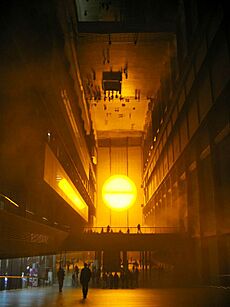
The Turbine Hall is famous for showing huge, specially made artworks by modern artists. These amazing pieces are usually on display from October to March each year.
From 2000 to 2012, a company called Unilever sponsored these artworks. Many famous artists created incredible installations here. For example, Olafur Eliasson created The Weather Project in 2003, which made the hall look like a giant sun. Rachel Whiteread filled the space with thousands of white boxes for her artwork EMBANKMENT in 2005.
Since 2013, Hyundai has sponsored these commissions. This is a ten-year program to bring new and exciting art to the Turbine Hall. Artists like Abraham Cruzvillegas and Kara Walker have created works for this series.
When there isn't a special commission, the Turbine Hall is used for other events and exhibitions.
Major Temporary Exhibitions
Tate Modern also has big temporary exhibitions that you need to buy a ticket for. These shows usually last for a few months. They often feature famous artists or specific art movements.
For example, a show about Henri Matisse in 2014 was incredibly popular. It had over 560,000 visitors! In 2021, an exhibition called A Year in Art: Australia 1992 was so popular it was extended for over a year.
In May 2025, Tate Modern celebrated its 25th birthday with a special "Birthday Weekender." A highlight was the return of Louise Bourgeois’s famous spider sculpture, Maman.
The Tanks
The Tanks on Level 0 are also used for art. One tank shows special installation and video art. Other smaller areas display video art from the museum's collection. The Tanks have even hosted live music events!
Other Cool Things to Do
Besides the art, Tate Modern has lots of other facilities:
- A big space in one of the Tanks for live performances.
- The Starr Auditorium and a seminar room for films and events.
- The Clore Education Centre and McAulay Studios for visiting schools and groups.
- Shops where you can buy books, prints, and souvenirs.
- Cafes, an espresso bar, a restaurant, and a members' room for food and drinks.
- A community garden that you can visit.
Getting There
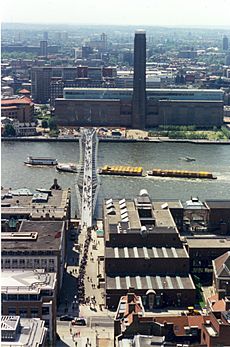
The closest train station is Blackfriars. You can also get there from Southwark, St Paul's, and Mansion House underground stations. If you walk from Southwark station, you'll see orange lampposts guiding the way!
There's also a riverboat stop right outside the gallery called Bankside Pier. You can take a boat to other parts of London or even a special "Tate to Tate" service that connects Tate Modern with Tate Britain.
Transport Connections
| Service | Station/Stop | Lines/Routes served | Distance from Tate Modern |
|---|---|---|---|
| London Buses |
Blackfriars Bridge |
381, N343, N381 | 0.2-mile walk |
| Blackfriars Bridge / South Side |
40, 63, N63, N89 | 0.2-mile walk | |
| Southwark Bridge / Bankside Pier |
344 | 0.4-mile walk | |
| London Underground |
Southwark |
0.4-mile walk | |
| National Rail |
Blackfriars |
Thameslink, Southeastern | 0.5-mile walk |
| London Bridge |
Thameslink, Southern, Southeastern | 0.7-mile walk | |
| London River Services |
Bankside Pier |
Commuter Service Tate to Tate Westminster to St Katharine's Circular |
Directors of Tate Modern
Here are the people who have led Tate Modern:
- Lars Nittve (1998–2001)
- Vicente Todolí (2003–2010)
- Chris Dercon (2010–2016)
- Frances Morris (2016–2023)
- Karin Hindsbo (2023–Present)
Protests at the Museum
Sometimes, people use the Tate Modern as a place to hold art protests. For example, an art group called Liberate Tate has protested there. They wanted the Tate to stop working with certain sponsors because of things they disagreed with. In 2015, a group of artists even stayed inside Tate Modern for 25 hours as part of a protest.
Images for kids
-
Georges Braque, 1909–10, La guitare (Mandora, La Mandore), oil on canvas, 71.1 x 55.9 cm
-
Pablo Picasso, 1909–10, Figure dans un Fauteuil (Seated Nude, Femme nue assise), oil on canvas, 92.1 x 73 cm.
-
Albert Gleizes, 1911, Portrait de Jacques Nayral, oil on canvas, 161.9 x 114 cm.
-
Robert Delaunay, 1912, Windows Open Simultaneously (First Part, Third Motif), oil on canvas, 45.7 x 37.5 cm
-
Juan Gris, 1914, The Sunblind, collage and oil on canvas, 92 × 72.5 cm
-
Claude Monet, 1916, Water-Lilies
-
Paul Klee, 1921, Abenteuer eines Fräuleins (A Young Lady's Adventure), watercolor on paper, 43.8 × 30.8 cm
-
Paul Klee, 1935, Walpurgisnacht (Walpurgian Night)
See also
 In Spanish: Tate Modern para niños
In Spanish: Tate Modern para niños
- List of most visited museums in the United Kingdom
- List of most visited art museums
- List of largest art museums
- List of museums in London


